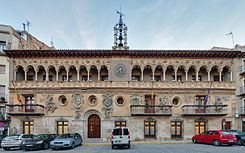Designated 2001 | Reference no. RI-51-0010839 | |
 | ||
Location Tarazona, Aragon, Spain Similar Tarazona Cathedral, Veruela Abbey, Moncayo Massif | ||
La fachada de la casa consistorial de tarazona quedar libre de veh culos
The Casa Consistorial de Tarazona, in Aragonese: Casa d'a Villa de Tarazona (Town Hall of Tarazona) is a building that houses the offices of the Council of the town of Tarazona, in Aragon, Spain. It is a good example of Spanish Renaissance art.
Contents
- La fachada de la casa consistorial de tarazona quedar libre de veh culos
- History
- Description
- Built in 1563
- Addition in 1973
- References
The town hall is located in Plaza de España square.
History
The building was built between the years 1557 and 1563 in the formerly called Plaza Mayor or del Mercado, to fulfill the function of Loncha, oxen place and granary since the city already had a Council Houses in Plaza de la Magdalena, in the Cinto's neighbourhood. The building, leaning against the rear in the stones of the Walls, was originally free, but now is located between shared walls. In mid-17th century this building became used as Town Hall.
Following the characteristics of all Lonchas, based in turn on the Aragonese private architecture, Tarazona had on the top floor with a "lookout" or gallery arches, with the function of false structure whose serves to protect the building, and topped in a blown wooden eaves. From this viewpoint the municipal corporation watched the bullfights that were held on the occasion of the festivities or particular of each guild, as well as religious events, such as the passage of Corpus Christi procession through the square. This function viewpoint of the Market was missing from the late eighteenth century due to the construction of the bullring situated next to the church of the Virgin River, patron of the city. We can say, almost certainly, the fish market had originally Tarazona four floors, although only three have reached our days.
From this lookout the city council watched the bullfights that were held on the occasion of the patron feasts or particulars of each guild, as well as religious events, such as the procession of Corpus Christi through the square. This function of the Loncha's lookout was missing from late-18th century due to the construction of the bullring situated next to the iglesia de la Virgen del Río. It can say, almost certainly, the Tarazonan Loncha had originally four floors, although only three have reached our days.
Description
The facade has three floors. In the exterior the building has a sculptural decoration that makes it unique and original and which was made in two moments.
Built in 1563
The facade is divided by a long frieze carved in plaster, dated in the years of its construction, which represents the departure of Charles V, Holy Roman Emperor (Charles I of Spain) after his coronation in Bologna, as emperor of the Holy Roman Empire by Pope Clement VII on February 24 of 1530, event narrated by chronicler Heinrich Cornelius Agrippa. In the frieze can distinguish, from left to right, the preparations for the feast, the guns accompanying the cortege, the squires carrying the banners, the royal entourage, the nobility, the Emperor and the pope under a canopy, and the passage of the entourage under a triumphal arch. Of the same time are the three coat of arms on leather trimmed. The central belongs to the Emperor Charles V, the left is that of Aragon, and that of Tarazona is the right one. All this decoration represents an iconographic program of imperial exaltation would find its justification in the death of the emperor coincided with the start of construction of the building.
However, the other reliefs on the facade of the main floor look different in terms of program and dating. First, it distinguish two allegorical figures representing Justice and Wisdom located one on each side of the main door, and the three Heraclean characters that refer to the founding of Tarazona. This iconographic program aims to reflect the virtues of good governance of the city, ie, justice and wisdom, which prudence and good advice were implicit, and the story of the founding of the town with the issues of Heracles, Cacus and a third character for some is Samson and other Pierres or even Tubal-cain. In this sense, it should not forget that the figure of Heracles was closely related to the Emperor Charles as he liked to be represented by the iconography of the twelve labors the mythological demi-god had to perform, transforming them into allegories of the ideology of power.
Addition in 1973
Practically from the completion of the building until today, the Town Hall has undergone many works, either by simple and small repairs, and for serious states of ruin. But the most radical restoration of the Town Hall was conducted between 1968 and 1973 under the direction of architect Fernando Chueca Goitia. Chueca created in the upper of third floor, a gallery of arches indiscriminately imitating the nearby Abbey of Santa María de Veruela's upper of the cloister, also wrong because included the shields of the Veruelan abbots Hernando de Aragón and Lope Marco in the decoration of the affected floor.
